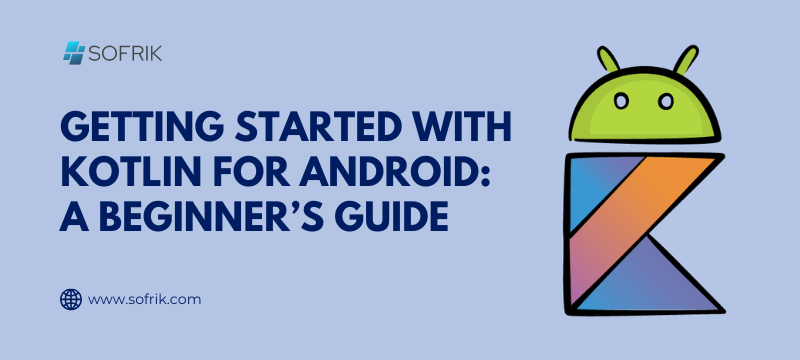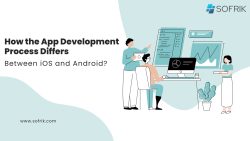Getting Started with Kotlin for Android: A Beginner’s Guide

If you’re stepping into the world of Android development, chances are you’ve heard of Kotlin. Since Google announced Kotlin for Android as an official language, it has rapidly become the go-to choice for modern app development. Whether you’re a budding programmer or transitioning from Java, Kotlin offers simplicity, safety, and powerful features.
In this beginner’s guide, we’ll walk you through everything you need to know to start building Android apps using the Kotlin programming language.
Why Kotlin for Android?
Kotlin is concise, expressive, and fully interoperable with Java, making it a seamless option for existing Android developers. Google’s own apps are now largely written using Kotlin, underlining its importance in the Android ecosystem.
Here’s why Kotlin for Android developers is gaining momentum:
-
Concise syntax reduces boilerplate code.
-
Null safety helps prevent runtime crashes.
-
Interoperability with Java enables gradual migration.
-
Coroutines simplify asynchronous programming.
-
Tooling support in Android Studio is robust.
At Sofrik, where innovation meets usability, we’ve seen a significant productivity boost after transitioning to Kotlin for Android app development.
Setting Up Your Development Environment
To start Android development with Kotlin, you need a few tools installed:
✅ Prerequisites:
-
Java Development Kit (JDK) – preferably version 11 or above
-
Android Studio – latest stable release
-
Kotlin Plugin – comes pre-installed in newer Android Studio versions
Once installed, start a new Android project and choose Kotlin as the programming language during setup. Android Studio will scaffold your project in Kotlin automatically.
Understanding Kotlin Basics
Before diving into full-fledged app development, let’s understand some Kotlin programming language fundamentals:
1. Variables and Data Types
-
val= immutable -
var= mutable
2. Functions
3. Control Flow
4. Classes and Objects
Once you’re comfortable with these basics, you’ll be well-prepared for more advanced Android concepts.
Building Your First Kotlin Android App
Let’s create a simple “Hello World” app using Kotlin:
-
Open Android Studio > Start a New Project
-
Select Empty Activity > Name your project
-
Choose Kotlin as the language
-
In
MainActivity.kt:
Hit Run, and your first Kotlin for Android app is live!
Best Practices for Kotlin Android Development
Once you’re familiar with the basics, keep these tips in mind:
-
Use Kotlin extensions like
syntheticorViewBindingfor cleaner UI code. -
Prefer immutable (
val) declarations over mutable ones (var) to avoid bugs. -
Use coroutines for asynchronous tasks like API calls.
-
Leverage sealed classes and data classes for managing UI states and models.
-
Break your app logic into MVVM architecture for scalability.
At Sofrik, we apply these practices to build powerful apps that scale—from eCommerce platforms to CRM tools.
Common Challenges (And How to Overcome Them)
Even though Kotlin for Android app development is beginner-friendly, here are some hurdles you might face:
-
NullPointerExceptions – Kotlin has built-in null safety. Use
?and!!operators wisely. -
Gradle sync errors – Always match Kotlin and Android Gradle Plugin versions.
-
Learning curve from Java – Take time understanding Kotlin’s functional paradigms (like lambdas, higher-order functions).
Luckily, the vibrant Kotlin community and Google’s official documentation can help you troubleshoot quickly.
Where to Learn More
To deepen your skills in Android development with Kotlin, explore:
-
Kotlinlang.org – Official documentation
-
Google’s Android Developer Courses
-
GitHub – Real-world open-source Kotlin projects
-
Udacity & Coursera – Structured beginner-to-pro tracks
Pro Tip: Bookmark blogs like Sofrik’s knowledge hub, where we share insights and tutorials for developers of all levels.
Why Kotlin Is the Future of Android Development
With its strong community support, first-class Android tooling, and powerful features, Kotlin for Android is here to stay. Companies like Pinterest, Netflix, and Uber are already using Kotlin in production.
At Sofrik, we’ve helped businesses modernize their apps with Kotlin — delivering faster development times, fewer bugs, and smoother user experiences.
✅ Conclusion
Getting started with Kotlin for Android is an exciting step toward building modern, reliable, and user-friendly mobile apps. With clean syntax, robust tools, and Google’s backing, Kotlin simplifies Android development for both beginners and experienced programmers.
Whether you’re creating your first app or improving an existing one, Kotlin offers the flexibility and power to bring your ideas to life.





